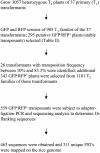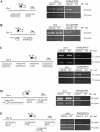A versatile transposon-based activation tag vector system for functional genomics in cereals and other monocot plants
- PMID: 17993541
- PMCID: PMC2230568
- DOI: 10.1104/pp.107.111427
A versatile transposon-based activation tag vector system for functional genomics in cereals and other monocot plants
Abstract
Transposon insertional mutagenesis is an effective alternative to T-DNA mutagenesis when transformation through tissue culture is inefficient as is the case for many crop species. When used as activation tags, transposons can be exploited to generate novel gain-of-function phenotypes without transformation and are of particular value in the study of polyploid plants where gene knockouts will not have phenotypes. We have developed an in cis-activation-tagging Ac-Ds transposon system in which a T-DNA vector carries a Dissociation (Ds) element containing 4x cauliflower mosaic virus enhancers along with the Activator (Ac) transposase gene. Stable Ds insertions were selected using green fluorescent protein and red fluorescent protein genes driven by promoters that are functional in maize (Zea mays) and rice (Oryza sativa). The system has been tested in rice, where 638 stable Ds insertions were selected from an initial set of 26 primary transformants. By analysis of 311 flanking sequences mapped to the rice genome, we could demonstrate the wide distribution of the elements over the rice chromosomes. Enhanced expression of rice genes adjacent to Ds insertions was detected in the insertion lines using semiquantitative reverse transcription-PCR method. The in cis-two-element vector system requires minimal number of primary transformants and eliminates the need for crossing, while the use of fluorescent markers instead of antibiotic or herbicide resistance increases the applicability to other plants and eliminates problems with escapes. Because Ac-Ds has been shown to transpose widely in the plant kingdom, the activation vector system developed in this study should be of utility more generally to other monocots.
Figures




Similar articles
-
Functional genomics of rice pollen and seed development by genome-wide transcript profiling and Ds insertion mutagenesis.Int J Biol Sci. 2010 Dec 30;7(1):28-40. doi: 10.7150/ijbs.7.28. Int J Biol Sci. 2010. PMID: 21209789 Free PMC article.
-
Trans-activation and stable integration of the maize transposable element Ds cotransfected with the Ac transposase gene in transgenic rice plants.Mol Gen Genet. 1993 Jun;239(3):354-60. doi: 10.1007/BF00276933. Mol Gen Genet. 1993. PMID: 8391111
-
A transgenic system for generation of transposon Ac/Ds-induced chromosome rearrangements in rice.Theor Appl Genet. 2012 Nov;125(7):1449-62. doi: 10.1007/s00122-012-1925-4. Epub 2012 Jul 14. Theor Appl Genet. 2012. PMID: 22798058 Free PMC article.
-
[Ac/Ds tagging system and functional genomics in rice].Zhi Wu Sheng Li Yu Fen Zi Sheng Wu Xue Xue Bao. 2005 Oct;31(5):441-50. Zhi Wu Sheng Li Yu Fen Zi Sheng Wu Xue Xue Bao. 2005. PMID: 16222085 Review. Chinese.
-
Transposon tagging in rice.Plant Mol Biol. 1997 Sep;35(1-2):219-29. Plant Mol Biol. 1997. PMID: 9291975 Review.
Cited by
-
An active ac/ds transposon system for activation tagging in tomato cultivar m82 using clonal propagation.Plant Physiol. 2013 May;162(1):145-56. doi: 10.1104/pp.113.213876. Epub 2013 Apr 8. Plant Physiol. 2013. PMID: 23569107 Free PMC article.
-
Efficient generation of marker-free transgenic rice plants using an improved transposon-mediated transgene reintegration strategy.Plant Physiol. 2015 Jan;167(1):11-24. doi: 10.1104/pp.114.246173. Epub 2014 Nov 4. Plant Physiol. 2015. PMID: 25371551 Free PMC article.
-
Gain-of-function mutagenesis through activation tagging identifies XPB2 and SEN1 helicase genes as potential targets for drought stress tolerance in rice.Theor Appl Genet. 2021 Jul;134(7):2253-2272. doi: 10.1007/s00122-021-03823-0. Epub 2021 Apr 5. Theor Appl Genet. 2021. PMID: 33821294
-
Co-culturing on dry filter paper significantly increased the efficiency of Agrobacterium-mediated transformations of maize immature embryos.Physiol Mol Biol Plants. 2019 Mar;25(2):549-560. doi: 10.1007/s12298-018-00641-5. Epub 2019 Feb 9. Physiol Mol Biol Plants. 2019. PMID: 30956435 Free PMC article.
-
Genetic Diversity of Selected Rice Genotypes under Water Stress Conditions.Plants (Basel). 2020 Dec 24;10(1):27. doi: 10.3390/plants10010027. Plants (Basel). 2020. PMID: 33374424 Free PMC article.
References
-
- Alonso JM, Stepanova AN, Leisse TJ, Kim CJ, Chen H, Shinn P, Stevenson DK, Zimmerman J, Barajas P, Cheuk R, et al (2003) Genome-wide insertional mutagenesis of Arabidopsis thaliana. Science 301 653–657 - PubMed
-
- Ayliffe MA, Pallotta M, Langridge P, Pryor AJ (2007) A barley activation tagging system. Plant Mol Biol 64 329–347 - PubMed
-
- Christensen AH, Quail PH (1996) Ubiquitin promoter-based vectors for high-level expression of selectable and/or screenable marker genes in monocotyledonous plants. Transgenic Res 5 213–218 - PubMed
Publication types
MeSH terms
Substances
LinkOut - more resources
Full Text Sources
Other Literature Sources

